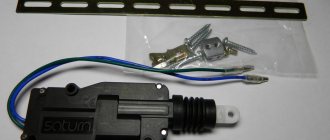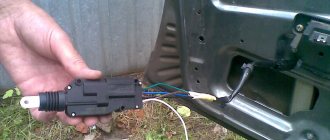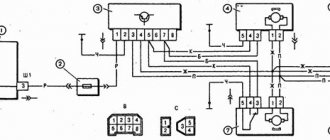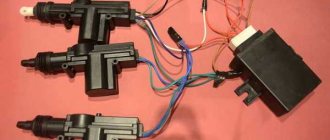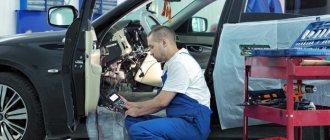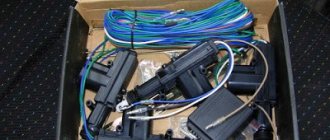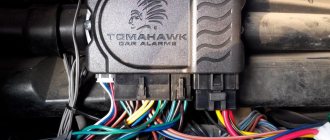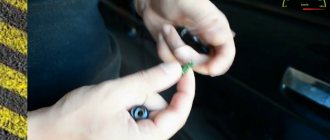Central locking (CL) is a very convenient thing that allows you to lock or unlock all the car doors at once with a slight movement of your hand. However, sometimes this system does not work correctly or does not respond at all to turning a key or pressing a button. What could be the reasons for a central locking malfunction?
Often the central locking, especially on domestic cars VAZ-2110, VAZ-2114, VAZ-2115 and their derivatives, begins to act up. It manifests itself like this: when you close the driver's door with the key, the other doors do not respond. If you move the key a little, the central locking works. Why is this happening?
Contacts in the main drive do not close
The central locking, powered by the driver's door lock, functions as follows: an electric drive is installed in the specified door, which not only controls its lock, but also sends signals to the central locking unit. The block distributes corresponding signals to drives installed in other doors.
The control actuator in the driver's door has five wires
For these purposes, an actuator is installed in the driver's door not with two, as usual, wires, but with five. Via additional wires, the drive “communicates” with the central locking unit. When the lock is locked, the driver's door control rod lowers and closes certain contacts inside its housing. The central locking unit receives voltage and gives a command to the lock drives of other doors to close. The same thing happens when opening, only the voltage flows through other wires and through other contacts, making it clear to the central locking unit that it needs to send a command to unlock the door locks.
In this case, the contacts inside the control drive may not always close at the right time. For example, this may occur due to improper adjustment of the linkage that connects the lock button on the door and the electric drive itself. That is, the button may already rest against the casing, preventing the rod from lowering further, but the contacts in the drive have not yet closed. Accordingly, it seems that the lock is locked (it may actually be locked on the driver’s door), but the other doors will not lock, since the rod needs to be lowered another couple of millimeters.
The same phenomenon occasionally occurs on the VAZ-2110, when the button gets pinched against the door trim and also prevents the rod from descending to the required depth. The most important “trick” is that this lowering may be enough for the mechanical lock to lock and it seems that the door is locked, and accordingly thoughts come about a malfunction of the entire central locking system. This is wrong.
When the central locking behaves this way, first of all you should make sure that the button is lowered all the way. To do this, with the door open, click the lock latch two clicks, simulating a closed door, turn the key and try to lower the button with your hand. If the central locking works, then you need to release the lock button from its tight contact with the door trim or adjust the linkage from it to the control drive.
Central locking fuse blown
If the central locking still does not respond to locking and unlocking the driver's door, then the problem is most likely electrical. The simplest reason is a blown fuse. Moreover, in the case of a central lock, it can burn out not only from a short circuit, but also from a normal overload. This happens when it is too difficult for the drives to move the lock rods, for example, due to improper adjustment of the rods or congealed lubricant in the lock. frozen locks using the key fob .
Broken central locking wires
Another reason why the central lock may not work completely or partially is a broken wire. Moreover, the wires break, as a rule, in those places where they are subject to bending loads - the entrance from the body pillar to the door. The driver's door is the most frequently opened door in any car, and the control drive is located there. This means that it is enough to break at least one wire that enters it from the rack and relates to the central lock, and the entire locking system may begin to work incorrectly.
The central locking does not work: signs of malfunction and causes of their occurrence
It happens that when the central lock located on the driver's door is closed, no action occurs on the other doors. However, as soon as you move it a little, the doors immediately closed. It is immediately clear that the problem here is the presence of malfunctions in the central locking and several reasons contribute to this.
Among all the possible causes of malfunctions, all the most basic ones can be identified.
No contact in the drive
With such a malfunction, the contacts inside the control drive do not close the necessary contacts in time. This happens for several reasons:
- The adjustment of the rod that connects the lock button and the drive is done incorrectly. This reason contributes to the incorrect position of the rod and lack of contact with the electric drive.
- The button touches part of the casing and does not allow it to lower to the required depth to ensure contact of the traction with the electric drive. Despite the fact that the driver's door closes, no signal comes to the other doors.
Check the condition of the metal rod.
When such problems occur in the operation of the central locking, first of all you need to make sure that the button is lowered to the very end. If for some reason this does not happen, first inspect the casing for burrs, and then inspect the rod for its even and accurate position.
Fuse blown
If manipulations with the central locking rod do not bring any results, and they do not react in any way to either opening or locking, then first of all you need to check its electrical circuit, and specifically the fuse. Because on the central lock it can fail not only if a short circuit occurs in the circuit, but also if the slightest overload occurs.
Circuit breakers
F1 (10 A) - rear fog lights, their activation lamp on the panel. Headlight cleaner motors (turn on). Headlight washer motor. If your rear fog lamps do not work, check the button to turn them on. When connecting a PTF, a fuse is usually installed, which is located directly on the wire behind the button. Check it out. Check the lamps. The PTF lights only when the low beam is on; this should be taken into account when searching for the cause.
If the headlight cleaner or washer does not work, see the information about relay K1, and also check the fluid level in the washer reservoir and its pump.
F2 (10 A) - turn signals, their relay-breaker and hazard warning lights. Hazard warning light. See information about relay K2, the main problems and solutions are described there.
F3 (7.5 A) - interior lighting.
Individual light lamps. Trunk lamp. Illumination of the ignition switch. Check engine lamp. Stop lights. Trip computer, clock.
If your brake lights stop working, check the fuse, although it is unlikely to be the problem. In models VAZ-2114, VAZ-2115, rear lamps are a disease. The problem is the board on which the lamps are installed. The solution is to replace this board with a new one, in this case it is not known how long the new one will work. The simplest solution is to solder the wires to the lamps directly, or replace the connectors with connectors from another VAZ model, for example 2106.
If it's not the circuit board, check the brake light switch (frog) located by the brake pedal. This can only be the case if none of the brake lights are on, even on the spoiler. If the signal on the spoiler is on, but the others are not on, the problem is most likely in the rear light board. Also check the chips that connect to this board and their contacts. If these connectors fail, they must be replaced or the contacts inside them must be bent.
The VAZ-2114 model has two brake light lamps, the VAZ-2115 model has four. The lamps themselves may also fail individually, you just may not notice it. In some cases, it may be the wiring under the dashboard. If you don’t understand electrics, contact a car service center; most of them have long learned to deal with such problems and it will not be difficult for the technician to find the fault.
F4 (20 A) - portable lamp. Heated rear window. See information about relay K7.
F5 (20 A) - sound signal.
Radiator cooling fan. For the sound signal, see the information about relay K6. If the fan does not work, first check the functionality of its motor. To do this, connect it directly to the battery. The fan should be spinning. If it works, check the coolant temperature sensor and its contacts. It might be the thermostat. Do not allow the engine to overheat by more than 100 degrees.
If the sensor is faulty, or a different type of sensor is installed, the arrow on the dashboard may show an incorrect temperature. Overheating is accompanied by boiling, bubbling or the release of vapors from under the coolant expansion tank cap.
The reason may be in the electronic control unit and in the temperature settings for turning the fan on and off. When the wires from the sensor on the upper pipe are disconnected and the ignition is on, the fan should work. This indicates the health of the electrical circuit. Also check the wiring that comes from the fan and all connectors. The wires could rub against the body, and the contacts in the connectors could melt or oxidize.
F6 (30 A) - electric windows. See information about relay K5.
F7 (30 A) - stove motor.
Windshield washer and headlight cleaner motors (in their operating mode). Cigarette lighter. Glove compartment lamp. Heated rear window (winding). Heater problems. If the stove operates only at the 3rd speed, and does not turn on at the first two, most likely the additional resistor through which voltage is supplied to the stove motor has burned out, or the contact on its connector has lost. The resistor is located above the gas pedal and looks like a plate.
If the stove does not work in any of the positions, check the switch itself on the panel and its contacts; the stove motor may also have burned out or its brushes may have worn out. To measure the voltage, look at the wiring or change the heater motor, you need to unscrew the heater fan casing, which is located under the hood. When installing a new motor, there may not be enough space to fit the entire motor into place. In this case, try either placing it sideways and then turning it, or first disassemble it into 2 parts and then assemble it in place. A new assembled motor costs about 800-1000 rubles.
The principle of operation of the central lock on the VAZ-2112
The central lock, which operates from the driver's door drive of the VAZ-2112, works as follows:
- The electric drive installed in the door is designed not only to control the lock, but also to issue a signal to the central locking unit. He, in turn, transmits commands to other doors to open and close the doors.
- In order for the driver's door drive to be so multifunctional, it has as many as five wires, unlike standard drives with two. Additional channels are intended for communication with the central locking control unit.
Drive for driver's and passenger's doors.
When the lock closes, the rod on the driver's door moves down, thereby closing certain contacts on the electric drive. From these actions, the central locking unit receives signals and transmits commands to the drives of all other door locks . Their discovery occurs in the same way.
The central lock on the VAZ-2114 is an excellent device with which you can open or close all the doors of the vehicle with a single movement. Over time, a situation arises when the car stops locking using the central locking or the locking occurs only once. In this case, we can judge that the device has failed.
Installation instructions for central locking
Before installing the central locking system, you should study the connection diagram
Photo gallery “Central locking diagrams”
1. Central locking diagram for VAZ 2114
2. Central locking diagram
3. Connection diagram of the central locking system to the alarm system
The central locking control module is located on the left side under the panel. There are 6 wires coming from it. To install the central locking system, you need to disconnect the brown and blue wires.
Before connecting, you need to check that activators with 5 outputs are installed in the doors. If they are missing, they should be installed.
In a car, the one responsible for opening the doors is usually white and connected to terminal 7. If there is no connection to terminals 7 - 5, then the 8th terminal is connected to the brown wire. This wire is responsible for opening the doors. Terminals 5 and 6 are for closing doors.
To install the central locking system, you must purchase additional items:
- 2-3 diodes 1N4001 at 1A;
- one diode 1N5401 3 A;
- 2 diodes of 4 or 5 A, if there are no separate outputs for turn signals.
The central locking VAZ 2114 (hereinafter referred to as CZ) is a mechanism that ensures the simultaneous closing or opening of all four doors in the car. This option is very convenient; it eliminates the need to reach out and lock the doors manually every time. Such centralized control comes in handy when installing car alarm systems, which significantly expands the possibilities and variations of the use of the locking mechanism.
The operation of the lock itself does not depend on whether the car engine is running or the fact that the ignition is turned on. Power is supplied directly from the battery. It is quite common for the system to malfunction. For example, when the locks of some doors close, but the rest do not. Or the closing process occurs with great difficulty, jamming, or partial failure of the latches. A situation familiar to many car enthusiasts, isn’t it? There are several reasons for the node to not work correctly; we will look at them in more detail.
Causes of malfunction
There are many reasons why the central locking on a VAZ-2114 stops working stably. All existing causes of malfunction can be divided into two subgroups: climatic effects and technical breakdown. In the first case, the lock begins to work unstably due to the influence of climate, that is, due to very low temperatures, as a result of which not only the lock, but also other systems may freeze.
Selecting a security alarm for installation on a domestic car
The function of remotely closing and unlocking all car doors is mandatory for all types of modern anti-theft alarms. It is impossible to install an alarm without a central lock, so car owners are forced to install a central lock before purchasing a security system.
The trade offers motorists hundreds of models of anti-theft alarms in a wide price and functional range.
When choosing a car alarm for installation on domestic cars, the main selection criteria for car owners are:
- Affordable security system price. Experienced car enthusiasts do not buy the cheapest anti-theft alarms, doubting their durability and quality of work. Most Russian drivers prefer to buy car alarms from the middle price range.
- System functionality. Ordinary owners of VAZ models consider the car alarm to include a remote key fob, two or three sensors, a siren, and connection cables as a sufficient set of options.
- Possibility of self-installation. To implement this requirement at the purchase stage, you need to be interested in the complexity of the electronic control unit for the security system, detailed diagrams and instructions for connecting the anti-theft alarm. When installing it yourself, minimal disruption to the standard electrical wiring is desirable; it is not recommended to interfere with the operation of existing mechanisms.
Owners of VAZ-made models do not need to worry about the difficulties of flashing factory protections or bypassing standard immobilizers. However, experts do not recommend that novice car tuning enthusiasts begin work by independently installing security systems equipped with:
- remote engine start (remote engine start based on temperature, timer);
- coded dialogue communication system, GSM modules;
- numerous additional options (starting from a smartphone, turning on heaters, air conditioners).
If you want to install a full set of security options on a VAZ model, you will have to contact a specialized service, where they can install additional equipment.
Principle of operation
How is the central locking system controlled on the VAZ-2114? The algorithm of the central locking operation is that a control pulse arrives at a certain point, as a result of which one relay with power contacts is activated. In one case the car is locked, in the other – vice versa. Central locking activators are connected to relay contact 30, and through closed contact 87, ground acts on both outputs of the activator. If one or another relay is triggered, then contact 30 will be connected to the positive, and as a result, temporary voltage will be supplied to the activator, which will set the rod in motion, which will either open or close the door.
Electrical diagram of VAZ-2115-01
Years of production 2115: 1997—2012. This is a circuit with a regular button for rear fog lights (with locking), a fluorescent interior light, a connector for the clock and an 8-pin connector for the injector wiring.
1 — block headlights; 2 — fog lights; 3 — air temperature sensor; 4 - generator; 5 — electric motor of the engine cooling system fan; 6 — fan motor activation sensor; 7 — engine compartment lamp switch; 8 — block for connection to a single-wire type audio signal; 9 — sound signal; 10 — oil level sensor; 11 — front brake pad wear sensors; 12 — washer fluid level sensor; 13 — spark plugs; 14 — ignition distributor sensor; 15 - switch; 16 — carburetor solenoid valve control unit; 17 — carburetor solenoid valve; 18 — carburetor limit switch; 19 — speed sensor; 20 - starter; 21 - battery; 22 — relay for turning on fog lights; 23 — coolant level sensor; 24 — brake fluid level sensor; 25 — reverse light switch; 26 — coolant temperature indicator sensor; 27 — engine compartment lamp; 28 — windshield wiper gearmotor; 29 — oil pressure warning lamp sensor; 30 — block for connecting to the rear window washer electric motor; 31 — electric motor for windshield washer; 32 — ignition coil; 33 — instrument cluster; 34 — mounting block; 35 — brake light switch; 36 — blocks connected to the injection system wiring harness; 37 — ignition switch unloading relay; 38 — ignition switch; 39 — glove box lighting lamp; 40 — switch for the glove compartment lighting lamp; 41 — rear window heating switch; 42 — fog light switch; 43 — fog light switch; 44 — external lighting switch; 45 — alarm switch; 46 — steering column switch; 47 — instrument lighting regulator; 48 — hydraulic corrector scale illumination lamp; 49 — socket for a portable lamp; 50 — side direction indicators; 51 — switches in the front door pillars; 52 — lamp for individual interior lighting; 53 — electric heater fan; 54 — additional resistor of the electric heater fan; 55 — heater electric fan switch; 56 — backlight lamp for the electric heater fan switch; 57 — backlight lamp for heater control levers; 58 — display unit of the on-board control system; 59 — trip computer; 60 — switches in the rear door pillars; 61 — block for connection to the clock; 62 — electric fuel pump with fuel level sensor; 63 — ashtray lighting lamp; 64 — cigarette lighter; 65 — trunk lighting; 66 — trunk light switch; 67 — interior lamp; 68 — parking brake warning lamp switch; 69 — external rear lights; 70 — internal rear lights; 71 — plugs for connecting to the rear window heating element; 72 — license plate lights; 73 - additional brake signal.
See the complete diagram in one file below (click to enlarge):
Circuit 2115 with “high” panel 21083 is similar to circuit 21099 (except for the rear harness).
Experts' opinions
Many experts who have encountered the problem that the central locking on a VAZ-2114 does not work argue that all problems with the device should be divided into certain categories. Below we will look at each of them.
- Complete device failure.
- Partial lock failure.
- Operation malfunctions due to mechanical, electrical or other defects.
If a problem occurs with the central locking, the car owner must independently determine which of the above categories the breakdown falls into. Therefore, repairing a fault should not begin with disassembling a particular unit - it is enough to conduct a thorough diagnosis of the equipment. Thanks to the diagnostics carried out, the car owner will not only reduce the time spent searching and solving the problem, but will also reduce the monetary costs of repairs.
Disconnection Guide
Do I need to turn off the immo or alarm and how to do it correctly? We invite you to take a closer look at these issues.
Is it necessary to disable the immobilizer on the fourteenth VAZ model?
If there is a need, then of course it is necessary. The need to turn off the alarm or immobilizer arises in cases where the system blocks engine operation and starting the power unit becomes impossible.
How to disable?
If we are talking about signaling, then first of all you need to know about the connection points that were used during installation. Every anti-theft system has an emergency stop button, usually called the Valet service button.
It doesn’t matter whether it’s a European emergency warning button for a VAZ 2114, a new model or an old one
The combination with the use of Euro emergency lights in the event of the anti-theft system being disabled is described in the operating manual. This process is individual for each individual signaling model, so we will not describe it. If the emergency lights on the “four” do not work, then you will have to turn off the central unit, but you cannot do without the help of a professional in this matter.
As for how to properly disable immo with your own hands, the procedure is as follows:
- First you need to find the block of the installed anti-theft system. If you installed the immobilizer yourself, you should know where the control module is located. If the installation is installed from the factory, then the module should be located inside the dashboard, directly under the steering wheel.
- Next, you need to disconnect the connector with the signal wires from the control module. Disconnect the wires and move them aside.
- Now you will need to find pins numbered 9 and 18, for a total of 20 pins on the connector.
- Contacts numbered 9 and 18 must be cut using a utility knife. Strip the contacts of the cut wires, then twist them as securely as possible and insulate them. Use electrical tape to insulate the section. By completing these steps, you can restore the K-Line diagnostic line, which will allow you to monitor the condition of the main systems and components of the vehicle.
- Next, reinstall the connector. This way you can disable the anti-theft system and start the engine. This method is the simplest, but it must be borne in mind that it does not guarantee the correct disabling of the anti-theft system.
Photo gallery “Reflashing the control unit”
A more complex, but more effective option is to reflash the control unit. To implement it, you will need a soldering iron, a computer with a flashing utility, and a board programmer.
Flashing is carried out as follows:
- First, the control module is removed from the car.
- Next, the cover of the device is opened.
- Now you need to find a board with immo data written on it. If your car uses the January control unit version 7.x, then the circuit designation is 24С04.
- Next, you have two options for solving the problem - you either install a new circuit, or you will clean the old one. To perform the cleaning, you will need a computer or laptop with a Windows operating system, as well as an appropriate memory cleaning utility. There are many programs on the Internet, you can select software for a specific ECU model.
- The next step will be to desolder the circuit using a soldering iron, as well as install a new board. Well, or you reflash the circuit, whatever. If we are talking about firmware, then with the help of a properly configured utility you can complete this task in just a few minutes.
- When the process is completed, all you have to do is solder back the new board and check the functionality of the system.
Sources
- avtozam.com/vaz/2114/vklyuchenie-i-otklyuchenie-immobilajzera/
- drive2.ru/b/2094661/
- ladaautos.ru/vaz-2114/kak-samomu-otklyuchit-immobilajzer-na-vaz-2114.html
Diagnosis of alarm malfunction
The central locking control activator is installed in the driver's door. As soon as this drive is activated, a signal is sent through the channels of the circuit between the remaining activators, according to which the desired action occurs. If an alarm system is installed on the car, the performance check should begin with it. To do this, you need to check the closure both with the key and with the key fob. If the car closes completely from the first, but not from the second, then the problem lies in the electrical alarm circuit or in the control circuit. It happens that the simplest reason for the car not being locked with the key fob is the weak charge used in the battery.
The device of the standard immobilizer APS-4
First, let's figure out what this immobilizer model is and what functions it does. This kind of device is designed to prevent your car’s engine from starting in cases where access to it is recognized by the system as unauthorized, in other words, in the event of a possible theft.
This can lead to a complete replacement of control and monitoring units in the event of defects. When the ignition is turned off, the immobilizer is activated automatically (the buzzer will emit a small sound signal, and the indicator will go into flashing mode every 2.5 seconds), switching to the theft protection mode.
Repairing broken wires
As a rule, most often the wires break off or break in the corrugation of the door. This is due to the fact that the door is constantly opening or closing, and the wire insulation is quite thin. To eliminate the problem of broken wires from the rubber corrugation of the door, you need to slowly pull out one wire at a time that approaches or departs from the central locking unit for power or control. A broken wire can easily be pulled out of the total mass. You can connect the break using a simple connection using male-female terminals. If the break occurs in another place, it is necessary to test all wiring with a multimeter. When checking, it is worth remembering that voltage will be present on one wire only at the moment of opening, and on the other - when closing the central lock.
Connection diagram
After carefully studying the alarm installation instructions, you can find the following connection diagram:
In this diagram, the designation X2 indicates a six-pin connector. It must be connected according to the diagram above. If you need to install an additional actuator, then it is better to use the diagram given in the instructions.
Now let's figure out how to connect the door sensors. For this purpose, there is a special wire in the connector marked X3.
Repair of electric central locking
The central locking system on a VAZ-2114 of this type begins to work intermittently after a while. They will be associated with temperature fluctuations. Most often, unstable operation of an electric central locking system will be observed at low temperatures or high air humidity, that is, in the autumn-winter period. At first, the mechanisms will jam slightly, then opening or closing will not occur at all. Most often, this problem occurs on domestic cars with pre-installed central locking from the manufacturer. It is better to replace locks with solenoids installed at the factory with central locking systems with motors, which will be more reliable.
READ ALSO ON THE SITE
One of the most common signs of a malfunction of the valves on the VAZ 2110/2112 is a distinct knocking sound when the engine is running. Also, improper operation of the valves may be indicated by stopping the engine when starting the car...
Thermal clearances in the valve mechanism serve to ensure a tight fit of the valve on the seat when the valve drive parts expand during engine operation. The thermal clearance of MAZ diesel engine valves...
Step-by-step instructions for adjusting the ignition timing of the UMZ 421 engine installed on UAZ and GAZelle cars. ➤ Using the starting handle (from the car tool kit), set the crankshaft to the position corresponding to the angle...
Central locking drive failure
If all the wiring is in good condition, then it also happens that the main activator, which closes the central locking on the VAZ-2114, breaks down. To solve the problem, just purchase a new main door activator. Just remember that you should buy a lock drive that has 5 wires, not 2. Since the five-wire one is installed on the control door, and the two-wire one is installed only on the controlled part.
So, we have looked at the main malfunctions that occur with the central locking on domestic Samara-2 cars.
Car modifications 2115
VAZ-2115. The very first car that was produced since 1997. It was equipped with a 1.5-liter carburetor engine producing 76 horsepower. The maximum speed was 165 km/h, and the acceleration time from 0 to 100 km/h was 13.2 seconds.
VAZ-21150. The next modification, released in 1998, was equipped with a 1.5-liter carburetor engine producing 68 horsepower. was discontinued in 2000.
VAZ-2115-20. A modification of the car released in 2000, equipped with a 1.5-liter VAZ-2111 injection engine with a power of 77.8 horsepower. The maximum speed was 170 km/h, and the acceleration time from 0 to 100 km/h was 14 seconds.
VAZ-2115-40. A modification with a 1.6-liter injection engine, which has been produced since 2003. The car's maximum speed was 158 km/h, and the acceleration time to 100 km/h took 13.2 seconds.
VAZ-2115-91. A car with a 1.3-liter Wankel rotary piston engine producing 135 horsepower. The maximum speed is 190 km/h, and the acceleration time to 100 km/h is 9 seconds.
VAZ-21154. The latest modification of the car with a new VAZ-11183 engine with a volume of 1596 cm3 and a power of 81 horsepower. Produced since 2007. The maximum speed and acceleration time to 100 km/h are exactly the same as that of the VAZ-2115-40.
